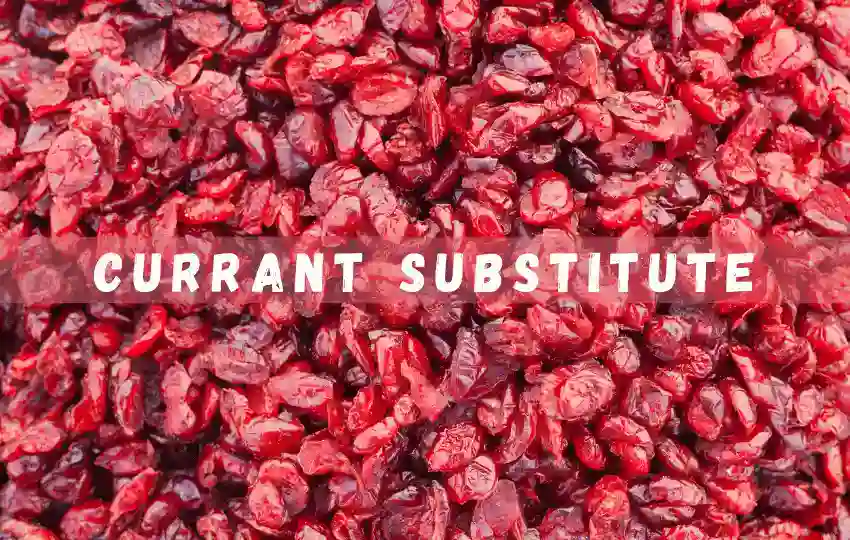Currants are known for their tart flavor and bright, colorful appearance. They are a popular ingredient in many baked goods, such as scones, muffins, and cakes.
But what if you don’t have currants on hand or just don’t like their taste? Don’t worry; there are plenty of delicious substitutes that you can use instead!
This post will discuss the 9 best currant substitutes and how to use them in your favorite recipes.
We will also provide you with the correct measurement ratio for each substitute. So, if you’re a cook in need of quick and ideal alternatives or substitutions with measurements, keep reading!
In short, " What can I use instead of currant?" Raisins, Dried Cranberries, Dried Cherries, Golden Raisins, Dried Blueberries, Fresh Cranberries, Dried Apricots, Chopped Dried Apricots, Chopped Dates.
What is currant, and what does currant taste like?
Currants are a type of small, dried fruit that is packed with flavor and nutrition. They have a sweet-tart taste with subtle notes of raisin, date, and plum.
Currants are especially high in antioxidants and vitamins C, B-6, K, E, A, riboflavin, niacin, calcium and iron.
The most common type of currant is the black currant. Other varieties include red or white currants as well as zante currants (which are actually just dried grapes).
All types of currants can be eaten raw or cooked into applications like pies, jams and compotes. They also work well as garnishes for soups and salads or mixed into yogurt or oatmeal.
Uses of currant
Currants are a type of small, round, dried fruit used for baking and culinary purposes. They are related to raisins, but their flavor is much more intense and tart.
Currants are often used in jams, jellies, pies, pastries, cakes, cookies, muffins, tarts and bread. They can also be added to salads or mixed into other dishes such as stuffings or sauces.
Currants can even be cooked into savory dishes like stews and curries.
For those who prefer not to bake with them can be ingested raw as a snack or sprinkled on top of breakfast cereals or yogurt for an added crunch and flavor.
Furthermore, currants have many health benefits associated with them.
They contain a high level of minerals such as calcium, iron and magnesium, which help promote bone health.
They also provide potassium which helps regulate the body’s fluid balance and reduce blood pressure levels.
Lastly, they have a high amount of fiber which aids digestion and helps keep the digestive system healthy.
They also include antioxidants that help protect cells from damage caused by environmental free radicals and diet-related issues like heart disease or cancer.
Where to buy currant?
If you are looking for where to buy currant, there are a few different places you can go. Many specialty food stores carry it, as do some international grocery stores.
You can also order online from many retailers that provide a variety of diverse flavors and types of currant.
Best currant substitutes with a ratio
1. Raisins – a good currant substitute
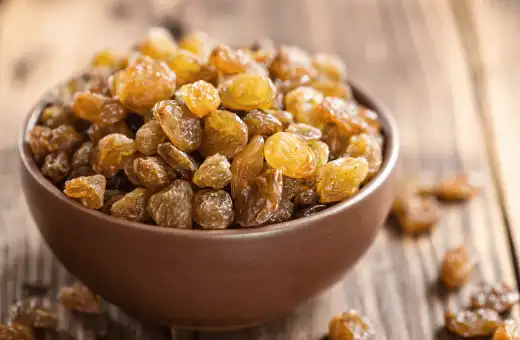
Raisins are perhaps the most popular currant substitute. Not only are they easy to find, but they’re also readily available year-round. They’re also sweet and tangy fruit, just like currants.
How to Use: Try soaking the raisins in hot water for about 10 minutes to make them plump before using, or bake them for a few minutes in the oven to dry them out.
Ratio: For every 1 cup of currants in a recipe, use 1 cup of raisins.
2. Dried Cranberries – similar to currant
Dried cranberries are another excellent alternative to currants. They have a similar tart flavor and work well in baked goods.
How to Use: Like raisins, you may want to soak dried cranberries in hot water for a few minutes to make them plump before using. But they can also be used dry.
Ratio: For every 1 cup of currants in a recipe, use 1 cup of dried cranberries.
3. Try Dried Cherries in place of currant
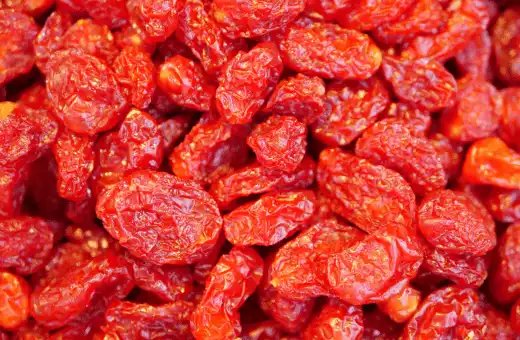
Dried cherries have a slightly sweet and tart flavor, making them a great alternative to currants in baking. They are also available year-round, making them easy to find.
How to Use: Like cranberries, if you’re using dried cherries, they may benefit from a quick soak in hot water to make them plumper before use. Dried cherries also lend a nice texture to baked goods
Ratio: For every 1 cup of currants in a recipe, use 1 cup of dried cherries.
4. Golden Raisins – similar to currant
Golden raisins are a dried version of the common grape. These raisins are a bit sweeter than their traditional counterparts, and their bright color can add a pop of color to baked goods.
How to Use: Golden raisins can be used dry as is.
Ratio: For every 1 cup of currants in a recipe, use 1 cup of golden raisins.
5. Dried Blueberries – a great currant alternative
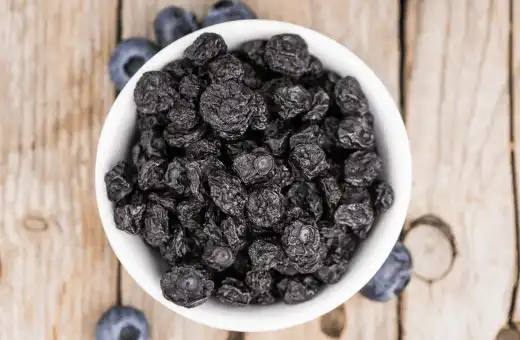
Dried blueberries have a similar flavor to currants but are a bit sweeter. They work particularly well in breakfast baked goods like muffins or scones.
How to Use: The recipe will remain the same, with no need to soak them.
Ratio: For every 1 cup of currants in a recipe, use 1 cup of dried blueberries.
6. Fresh Cranberries – similar to currant
While fresh cranberries are relatively sour when eaten as a snack, they work as a great substitute for currants in baking recipes.
Their tartness adds interest to baked goods, and they’re readily available during the holiday season.
How to Use: Fresh cranberries can be used as is. You may want to slice them in half to prevent having big cranberry chunks in your baked goods.
Ratio: For every 1 cup of currants in a recipe, use 1 cup of fresh cranberries.
Read more: Best substitutes for Cranberry juice
7. You can use Dried apricots instead of currant

Dried apricots have a sweet and slightly nutty flavor that works well as a currant substitute. They add moisture and texture to the baked goods.
How to Use: Soak the dried apricots in hot water for about 10 minutes to make them plump before using.
Ratio: For every 1 cup of currants in a recipe, use 1 cup of dried apricots.
8. Chopped Dried Apricots – similar to currant
Chopped dried apricots offer a unique taste and texture that can be a great alternative to currants. They have a sweet and chewy texture that can complement many different flavors.
Ratio: Use the same amount of chopped dried apricots as you would currants.
9. Chopped Dates – a decent currant replacement
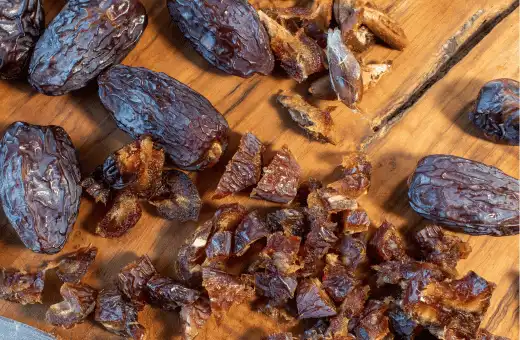
Chopped dates are a great option if you want a substitute that is both sweet and chewy. They have a rich, caramel-like flavor that can add depth to your recipes.
Ratio: Use the same amount of chopped dates as you would currants when substituting.
Tips on How to Choose the Most Suitable Substitution Option for currant
When selecting a suitable substitution option for currants, consider the following tips:
1. Flavor Profile: Currants have a unique sweet-tart flavor that adds a distinct taste to recipes. When choosing a substitute, look for ingredients with a similar flavor profile.
Dried cranberries, raisins, or chopped dried cherries can provide a comparable sweet-tart taste.
2. Texture: Consider the texture of currants and how they contribute to the overall mouthfeel of a dish.
If you’re looking for a substitute with a similar texture, dried cranberries or chopped dried cherries can be good options. Raisins are softer and chewier but can still work well in many recipes.
3. Recipe Compatibility: Think about the specific recipe you’re preparing and choose a substitute that complements the other ingredients.
For example, dried cranberries might be a suitable substitute in baked goods like scones or muffins, while chopped dried cherries can work well in salads or savory dishes.
4. Sweetness Level: Take into account the sweetness of currants and adjust the sweetness level of the substitute accordingly.
If currants provide a slightly tangy or tart element in your recipe, consider reducing the overall sweetness of the substitute ingredient to maintain a balanced flavor.
5. Availability and Price: Consider the availability and cost of the substitute option in your area. Dried cranberries and raisins are typically more readily available and affordable compared to other dried fruits.
However, if you’re looking for a specific flavor, like cherries, you may need to check specialty stores or online retailers.
6. Experiment and Adjust: Conduct taste tests with different substitution options to determine their impact on the overall flavor of your recipe.
Adjust the quantities or make any necessary modifications based on your taste preferences and the desired outcome.
7. Consider Combination: If a single substitute option doesn’t fully replicate the flavor of currants, consider combining different dried fruits.
For example, you could mix dried cranberries with chopped dried cherries to achieve a flavor profile closer to currants.
Remember, while a substitution may not provide an exact replica of currants, it can still enhance the taste and texture of your recipe. Adapt the substitute to suit your preferences and the specific requirements of the dish you’re preparing.
Substitute for currants in baking
When baking, raisins are a great substitute for currants. Raisins are made from dried grapes and have a mixture of sweet and tart flavors, making them versatile in baking.
They can be counted as bread, cakes, muffins, cookies, and more.
Raisins also add texture and moisture to baked goods. To use them as a substitute for currants in baking recipes, simply replace the amount of currants called for with an equal amount of raisins.
When substituting for currants in recipes that require soaking or boiling before baking, it is recommended to soak the raisins beforehand in hot water for 15 minutes to soften them up.
Substitute for fresh red currants
Substituting fresh red currants in recipes can be a great way to add tangy flavor and bright color to dishes.
Fresh cranberries make a great substitution, as they have a similar tartness and can range in color from pink to ruby red.
Additionally, pomegranate arils are another excellent substitution, as they provide juicy sweetness with a hint of tartness.
Finally, fresh raspberry or blueberry puree can add sweetness and subtle berry flavors to dishes that call for currants.
Substitute for currants in cookies
Raisins make for a great substitution for currants in cookies. They are made from dried grapes and are small, sweet, and chewy.
Raisins come in many varieties and can be found in many stores year-round.
They can be used to replace currants in classic oatmeal cookies, as well as chocolate chip cookies and other recipes.
Additionally, raisins can provide a subtle hint of sweetness when mixed with nuts, oats, or whole wheat flour.
Substitute for currants in Christmas cake
A currant-less Christmas cake can be made by substituting other dried fruits such as raisins, sultanas, or cranberries in equal quantities.
Figs are also a great substitution and will add sweetness and texture.
You can also add other festive ingredients, such as candied citrus peel, nuts, or cherries, for added flavor.
If you prefer to avoid dried fruit altogether, chopped apples and pears are a good alternative that will still provide moisture and sweetness.
Additionally, adding spices like nutmeg, cinnamon, ginger, and cloves will give the cake an extra festive flavor.
Substitute for currants in salad
In salads, dried cherries or cranberries can be used as a substitute for currants. Dried cherries and cranberries are tart in flavor, providing the same acidic character as currants.
They are also a good source of nutrition, offering vitamins A and C, as well as antioxidants and dietary fiber.
Additionally, they can add a burst of bright color to any salad. For an even more flavorful substitution, try dried goji berries or raisins.
The sweetness of goji berries will provide a milder flavor than currants, while raisins bring a familiar sweetness that pairs well with other salad ingredients.
Substitute for currants in Irish soda bread
One possible substitution for currants in Irish soda bread is to use raisins. Raisins are made from dried grapes, while currants are made from smaller, much sweeter berries called Zante currants.
Replacing the currants with raisins will give the Irish soda bread a slightly different flavor, but it will still be quite tasty.
Both ingredients add sweetness and texture to the bread.
When substituting raisins for currants, it’s important to use more than if you were using currants since raisins are larger.
If using a standard recipe that calls for one cup of currants, you should use at least one and a half cups of raisins instead.
Substitute for currants in sauce
Raisins can be used as a substitute for currants in sauce. Unlike currants, which are dried, seedless grapes, raisins are made from mature grapes that have been sun-dried to concentrate their sweetness.
They are high in natural sugar and acidity, making them an ideal option for adding flavor and sweetness to a wide variety of sauces.
When using raisins instead of currants, it is recommended that the raisins be soaked in warm water for about 15 minutes before adding them to the sauce; this will help prevent them from clumping together or becoming too dry when cooked.
Additionally, while currants provide a slightly tart flavor, replacing them with raisins will result in a sweeter taste profile.
Discover more: Best Orange juice substitutes
Conclusion on currant substitute
In conclusion, there are plenty of currant substitutions that you can use in your baking.
Dried cranberries, raisins, dried cherries, chopped dried apricots, dried blueberries, golden raisins, and chopped dates are all great alternatives that can be used interchangeably with currants.
Remember to use the same amount of substitute as you would for currants when measuring.
So, next time you find yourself without currants or simply want to try something new, give one of these options a try!
FAQs on currant substitute
Q1. What is similar to currant?
Raisins are similar to currants, but they are smaller in size and come from dried grapes. Currants can be either black, red, or white and come from small berries that grow on shrubs in the Ribes family.
They have a tart flavor and are often used in baking and savory dishes. Both currants and raisins can be used interchangeably in recipes depending on the desired flavor or texture of the finished product.
Q2. What fruit is most like a currant?
The fruit that is most similar in flavor to a currant is a blackberry. Like a currant, blackberries are tart and sweet, with a juicy texture and slight tanginess.
They both share the same deep purple hue and small size, allowing them to be used interchangeably in baking recipes.
Both fruits are also rich in antioxidants and vitamins, making them both excellent sources of nutrition. In addition, both have similar growing requirements and can be found around the world in various regions with temperate climates.
Q3. Are raisins and currants the same thing?
No, raisins and currants are not the same thing. Raisins are dried grapes that have been desiccated until they become wrinkled and dark in color, while currants are small dried berries that come from the shrub known as the “Ribes” family.
Both raisins and currants can be used as a sweetener or in baking; however, there are some key differences between them that should be considered.
Raisins tend to be sweet and have a chewy texture when eaten, while currants are much smaller and have a tart flavor. The color of raisins can range from light yellow to deep brown, depending on how they were treated before being dried. Currants can range from deep black to bright red in color.
Additionally, they contain more natural antioxidants than raisins due to their higher concentration of tannins.
When it comes to nutrition, raisins contain more fiber than currants but provide less calcium. On the other hand, currants pack more vitamin C compared to raisins and also offer higher amounts of potassium, magnesium, and iron than their counterpart.
Q4. Can I use raisins instead of currants for Christmas cake?
Yes, you can certainly use raisins instead of currants in Christmas cake. Raisins are a great substitute for currants because they have a similar sweet-tart flavor that adds complexity and depth to the cake.
They also provide a nice texture and add moisture to the cake. Additionally, raisins can be soaked in brandy or rum to add even more flavor or even used in combination with currants to give your Christmas cake a unique flavor profile.
Q5. Do currants taste like cranberries?
No, currants and cranberries do not share the same taste. Currants have a sweet, tart flavor that is similar to raisins or grapes and can be eaten as a snack. Cranberries, on the other hand, have a sharp, acidic flavor with hints of bitterness that make them more suitable for use in baking or sauces.
Both fruits are high in vitamin C and antioxidants, but they differ significantly in terms of their nutritional value and flavor. Currants are higher in fiber than cranberries and can also supply a good source of potassium.
Cranberries contain up to four times more manganese than currants and are rich in polyphenols which makes them beneficial for promoting heart health.

